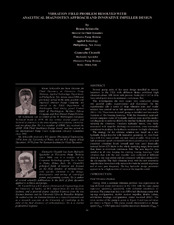| dc.contributor.other | International Pump Users Symposium (23rd : 2007) | |
| dc.creator | Schiavello, Bruno | |
| dc.creator | Cicatelli, Giancarlo | |
| dc.date.accessioned | 2017-10-05T15:22:22Z | |
| dc.date.available | 2017-10-05T15:22:22Z | |
| dc.date.issued | 2007 | |
| dc.identifier.uri | https://hdl.handle.net/1969.1/163944 | |
| dc.description | Lecture | en |
| dc.description | pg. 39 | en |
| dc.description.abstract | Several pump units of the same design installed in various locations is the USA with different duties exhibited high vibrations above API limits with process fluids (SG - 0.5 to 0.6) from rated point down to minimum continuous flow. The investigation for root cause was conducted along two parallel paths: experimental and theoretical. On the experimental side a series of shop vibration tests and modal analysis was carried out at full operational speed and cold water (SG 1.0). These tests included: pump as installed and two modifications of the bearing housings. With the theoretical approach several computer codes of hydraulic analysis were used for analytical diagnosis in order to identify the internal hydraulic phenomena inducing the vibrations. Unsteady hydraulic forces, very likely associated with impeller discharge recirculation, were eventually considered to produce the hydraulic excitation for high vibrations. The strategy for the ultimate solution was based on a new hydraulic design impeller with innovative geometry, i.e., two blade rows with five vanes at inlet and nine vanes at outlet. Shop tests at full operational speed confirmed both the expected pump curve and presented vibrations levels (overall and vane pass) drastically reduced below API limits in the whole operating range, from rated flow down to minimum continuous flow the new impeller was installed in all sites keeping the existing bearing housings. Field vibration data with the new impeller were collected at different times in a one year period and are compared with data produced by the old impeller. The field vibration levels with the new innovative impeller have been drastically reduced for both the overall amplitude and at vane pass frequency. The key hydraulic design parameter appears to be a high number of vanes at the impeller outlet. | en |
| dc.format.medium | Electronic | en |
| dc.format.mimetype | application/pdf | |
| dc.language.iso | en | |
| dc.publisher | Texas A&M University. Turbomachinery Laboratories | |
| dc.relation.ispartof | Proceedings of the 23rd International Pump Users Symposium | en |
| dc.subject.lcsh | Pumping machinery | en |
| dc.title | Vibration Field Problem Resolved With Analytical Diagnostic Approach And Innovative Impeller Design | en |
| dc.type.genre | Presentation | en |
| dc.type.material | Text | en |
| dc.identifier.doi | https://doi.org/10.21423/R10670 | |


